This post contains affiliate links.
Imagine standing at the foot of a vast, open earth – the breeze is gentle, the sky a colossal dome above, and in your hands, the chance to uncover the wondrous secrets of our planet. This is the embodiment of rock collecting for beginners, where each stone, each mineral, carries a tale millions of years old. As you venture out, eager to grasp how to start rockhounding, consider the path ahead: a blend of curiosity, respect for nature, and the timeless joy of discovery. Your journey begins with a solid foundation, rooted in understanding your surroundings, learning from the silent wisdom of the earth, and embracing the adventure with every tool and guide that enables your search for beauty etched in stone.
This Beginner’s Guide to Rockhounding is designed to unfurl the map that leads to the treasures beneath our feet. Just beyond the reach of your doorsteps, realms of hidden gems await, each beckoning with the allure of history’s embrace. Let’s prepare to step into the world of rockhounding with confidence and spirit, as you embark on an odyssey that thrills the soul and enriches the mind.
Key Takeaways
- Start by understanding your local geology to identify what you can find in your area.
- Books and local guides are crucial in pinpointing safe and legal rockhounding locations.
- Verify the legality of collecting on public lands, such as National Forests and BLM territories.
- Consider joining a local rockhounding club or visiting pay-to-dig sites to ease into the hobby.
- Prepare for your adventures with appropriate tools, and embrace the ethics of rockhounding with respect for the land.
- Rockhounding is not only about the finds but the fulfillment of nurturing a deep connection with nature.
Embarking on Your Rockhounding Journey
Stepping into the world of rockhounding welcomes not only the excitement of discovery but also the need for preparation. Before setting out with your essential rockhounding tools in hand, gaining an awareness of the geological landscape that awaits you is crucial.
Understanding Your Local Geology
Begin by acquainting yourself with the terrain. Different rockhounding locations for beginners offer a variety of minerals and formations. Explore authoritative local maps and resources to understand the areas that are rich in geologic history and prepped for your exploration.
Essential Reads: Gem Guides and Rockhounding Books
Dig into the soil of knowledge by seeking trusted rockhounding guides and literature. Authors like John Sinkankas have paved the way with key insights into gem identification and rockhounding basics, allowing you to understand what treasures await beneath the surface.
“No stone unturned, no crystal unfound, each rock tells a story of a time unknown.” – The Mineralogical Record
Navigating Legalities and Property Rights
Rockhounding is not free from rules. Ensure your adventure adheres to legal guidelines. Understand property rights, research current permits and restrictions, and respect land ownership to uphold ethical collecting practices.
- Verify land status through BLM or local authorities
- Seek permission for private land
- Be aware of protected areas and national parks
Grasping these rockhounding basics, equipped with the right set of tools, and a strong ethical compass will set the groundwork for a fulfilling and sustainable rockhounding journey.
Beginner’s Guide to Rockhounding
Embarking on the path of rockhounding 101 is a journey filled with excitement and learning. It’s a hobby that marries the thrill of exploration with the satisfaction of scientific discovery. To set off on the right foot, it’s essential to understand that rockhounding is as much about patience and perseverance as it is about the specimens you collect. Whether you’re identifying rocks and minerals for the first time or adding another find to your burgeoning collection, every step taken is an investment in your rockhounding proficiency.
Setting Realistic Expectations
Imagine the moment when you hold your first find – that unique stone that glimmers with potential. As a novice in beginner rock and mineral identification, it’s important to temper that excitement with the understanding that not every rock or mineral is a showcase piece. Those ‘museum grade’ treasures are the result of years of accumulated knowledge and experience. Instead, focus on the small victories and the knowledge gained with each outing.
Rockhounding Ethics: Respect the Land and Claims
As you step out, equipped with your rock hammer and enthusiasm, remember the mantra of every responsible rockhound – respect the land. Adherence to rockhounding ethics not only protects the environment but also ensures the future of this pastime. Navigating public lands can often present opportunities for new finds, but it’s vital to consult with authorities like the BLM or National Forest websites to confirm you’re collecting within legal boundaries. Let’s keep our hobby sustainable for generations by practicing diligent stewardship of the land.
Finding Rockhounding Locations for Beginners
If you’re eager to learn how to start rockhounding, the very first step is to identify accessible rockhounding locations for beginners. Discovering where and how to hunt for geological treasures can make all the difference in developing your new hobby. From scenic public lands with a plethora of minerals to family-friendly pay-to-dig sites that provide guidance, we cover the bases to get you started on the right foot.
Public Lands and Safe Collecting Spots
Public lands are the bread and butter of rockhounding spots for beginners. Usually managed by local or federal government agencies, these areas are open for educational and recreational pursuits such as rockhounding. To ensure you’re within legal boundaries, it’s essential to do a bit of homework. Check with the Bureau of Land Management, local state parks, or the US Forest Service to find specific areas where you’re allowed to collect rocks, gems, and minerals.
The Role of Pay-to-Dig Sites in Learning
For beginners, pay-to-dig sites are invaluable in offering a structured and insightful introduction to rockhounding. Here, for a day-fee, you’re granted access to rich mining tailings and pits where you can safely search for various minerals and gems. These locations are especially beneficial for those who are just learning about rock identification and proper digging techniques. The controlled environment also means you’ll often have the guidance of experienced staff who can point you in the right direction.
| Public Land | Type of Collectibles | Region |
|---|---|---|
| Bureau of Land Management (BLM) | Rocks, Minerals, Fossils | Western States |
| State Parks | Geodes, Agates | Varies by State |
| National Forests | Crystals, Petrified Wood | Throughout the USA |
| Pay-to-Dig Sites | Diverse (often area-specific) | Nationally Available |
By utilizing these resources, you can confidently embark on rockhounding adventures, knowing you’re in compliance with local regulations and within an environment suited to facilitate your learning. Remember to always leave the sites as you found them, and respect the collection limits set forth, preserving these treasures for fellow rockhounds and future generations.
Joining the Rockhound Community
If you’re setting out on your rockhounding journey, one of the most beginner-friendly rockhounding tips is to become part of the broader rockhounding community. By joining local clubs and societies, you can tap into a reservoir of collective expertise that dramatically enriches your rockhounding experience. Engaging with seasoned collectors can not only offer guidance but also provide you with invaluable hands-on opportunities for learning.
Learning from Local Rockhounding Clubs and Societies
Local rockhounding clubs and societies are the cornerstone of the rockhounding community. They are the perfect gateway for absorbing wisdom from veterans who know the lay of the land and the secrets beneath it. If you’re compiling a beginner’s guide to rockhounding, ensure it includes how to find and integrate with these organizations. Below is a table listing the types of activities and opportunities these groups often provide:
| Activity | Purpose | Benefit to Beginners |
|---|---|---|
| Group Excursions | To explore new or popular dig sites | Learn the ropes under the guidance of experienced rockhounds |
| Educational Meetings | To share knowledge and experience | Gain insights into geological and identification skills |
| Access to Resources | Use of libraries with exclusive books and maps | Discover locations and techniques that are not widely known |
| Equipment Sharing | Lend and borrow specialized tools | Try out different tools before investing in your own |
Rookies should look for clubs and societies by scanning local newspapers or conducting online searches, keeping in mind that these groups are invaluable aids to help you immerse yourself in the adventure of rockhounding. Essentially, these communities provide a comprehensive support system, helping to elevate the hobby from a solitary pursuit to a collective endeavor.
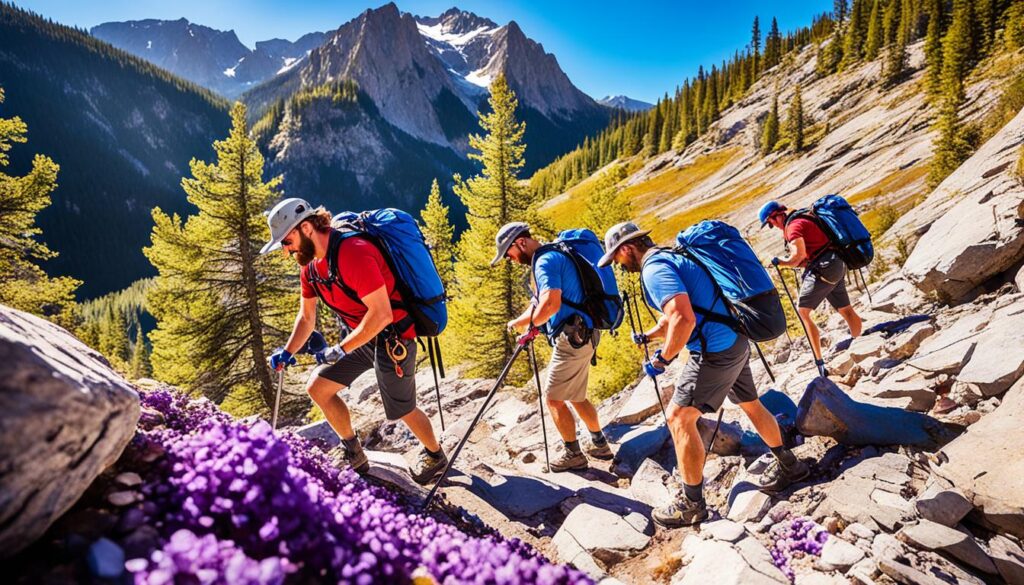
Remember, the friendships and connections made within the rockhounding community are as precious as the minerals and gems you seek. So, let your curiosity lead the way and let the experienced enthusiasts amongst the rockhounding community enrich your journey as you delve into the rewarding world of rockhounding.
Gearing Up: Essential Rockhounding Tools
As you set out on your rockhounding adventure, equipping yourself with the proper tools is a crucial step towards ensuring a successful and satisfying outing. The terrain and the specific rocks you are aiming to collect strongly influence the type of equipment you need. Prioritizing safety with the right safety equipment for rockhounding is also a key component of your preparation.
Selecting the Right Tools for the Terrain
Different environments call for different tools, and having a fundamental understanding of what to use is important. For collecting samples from soft sedimentary rocks, a standard rock hammer might suffice, but when you encounter tougher material like granite, a pick axe or a chisel could be essential rockhounding tools to add to your kit.
Consider that softer terrain won’t require heavy-duty tools which could damage fragile specimens, while more solid ground might necessitate stronger, more durable equipment.
Rockhounding Safety Equipment
Rigorous protection begins with opting for a hard hat when working under cliffs or in areas with potential for rock falls, and safety goggles are indispensable for shielding your eyes from chips and dust. Sturdy boots provide the footing needed on uneven terrain, and gloves will protect your hands from sharp edges. Remember, no matter the adventure, your safety is paramount.
- Hard Hat – For head protection in rocky areas
- Safety Goggles – To prevent eye injuries from flying debris
- Sturdy Boots – Essential for grip and protection on rocky terrain
- Durable Gloves – For handling sharp or rough specimens safely
- Sun Protection – Including sunscreen and a brimmed hat for long periods outdoors
By arming yourself with these essential tools and safety equipment, you are setting the stage for an enjoyable rockhounding experience that emphasizes both discovery and well-being.
Rock and Mineral Identification Basics
Embarking on the journey of beginner rock and mineral identification is a pivotal step in your rockhounding adventure. It’s not just about collecting stones; it’s about uncovering the story that each mineral tells. Identifying rocks and minerals is a skill that grows over time, with each expedition bringing new learning opportunities.
For starters, arm yourself with trustworthy reference materials or employ the convenience of rock identification apps. These tools are your compass for navigating the intricate world of mineralogy. Consider also the wealth of collective wisdom found in online forums, such as Reddit’s rockhounding group, where enthusiasts converge to exchange tips and discoveries.
- Examine the color and texture of your finds.
- Take note of the hardness by doing a scratch test.
- Observe any unique characteristics like luster or streak.
Remember, your finds are more than just stones; they’re tangible geological records. Every find has its own GPS coordinates — make sure to catalog the location of each, forming a map that traces back to the heart of your adventures.
| Property | Observation Technique | Examples |
|---|---|---|
| Color | Visual Inspection | Quartz (varied), Hematite (gray), Azurite (blue) |
| Texture | Touch and Visual Analysis | Sandstone (gritty), Slate (smooth) |
| Hardness | Scratch Test | Talc (soft), Diamond (hard) |
| Luster | Observe Reflection | Pyrite (metallic), Opal (silky) |
Enhance the value of your collection through the careful identification and understanding of each rock and mineral. Endeavor to grasp their composition and delve into their backstory — how they were formed and what they tell us about our planet’s history. This cultivates not only your collection but an intrinsic appreciation for the natural world.
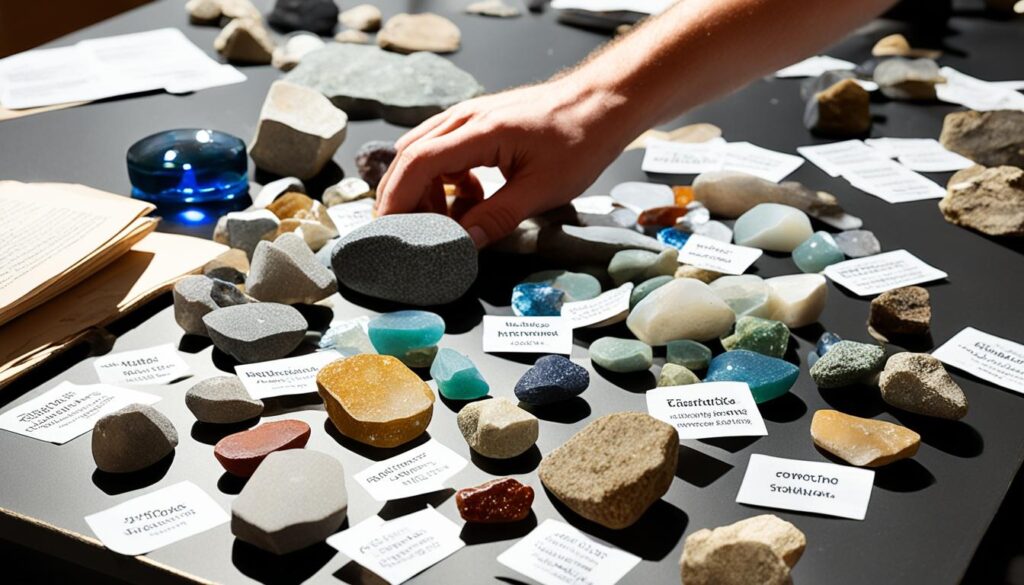
Your quest to master beginner rock and mineral identification is both scientific and artistic, requiring keen observation and an analytical mind. Exercise patience and allow your proficiency in identifying rocks and minerals to flourish with every outing. It’s a lifelong learning curve that is both educational and immensely satisfying.
Planning Your First Rockhounding Trip
Setting out on a rockhounding adventure is an exciting endeavor, particularly if you’re new to this engaging hobby. Proper preparation is essential to ensure a safe, productive, and enjoyable experience. Below, you’ll find indispensable steps to help you plan your trip effectively, covering everything from research to packing the right gear.
Preparing Your Itinerary and Research
Embarking on your first rockhounding excursion requires diligent research. It’s not just about finding any location, but rather identifying the sites that will offer you the best chance of success. This involves:
- Studying dependable sources to learn about the geology of the area
- Finding legitimate sites that welcome collecting
- Gaining insights on the types of rocks and minerals you might encounter
Creating a comprehensive itinerary not only guides your trip but helps you set realistic goals for your rock-collecting outings. Use trusted online resources or connect with local experts to ensure your list includes potential hotspots for digging and that you’re aware of any permissions needed to collect there.
Packing for a Successful Outing
Once your itinerary is laid out, it’s time to focus on what to bring. Remember, the goal is to be prepared for various situations without overpacking. Your backpack should include:
| Essential Items | Why It’s Needed |
|---|---|
| Rock Hammer and Chisels | For extracting and splitting rock specimens |
| Protective Gear (Gloves, Goggles, and Hat) | To keep you safe from sharp rocks and debris |
| Navigation Tools (GPS, Maps) | For finding your way to the site and ensuring a safe return |
| Plenty of Water and Snacks | Hydration and energy are vital, especially in remote areas |
| First Aid Kit | In case of minor injuries or emergencies |
Double-check your gear before you leave, and ensure that every item serves a purpose. A well-packed kit will allow you to approach your rockhounding trip with confidence and with the right mindset to explore and enjoy nature’s geological treasures.
In the next section, we’ll delve into maintaining and displaying your newfound collection, guaranteeing that each rock or mineral you unearth has a special place in your rockhounding journey.
Maintaining and Displaying Your Collection
As a devoted rockhound, you know the importance of both maintaining your rock collection and creating a rock display that is as educational as it is eye-catching. With the right approach to cataloging and setting up an appealing display, each piece in your collection can tell its own story, not just about its geological origin, but also about your journey as a collector.
Cataloging and Labeling Finds
Effective organization starts with careful cataloging. By labeling each specimen with key details, you’re not just keeping track, you’re preserving the context of each find which is essential for any serious collector. The classifications you choose now will lay the groundwork for both the maintenance and future expansion of your burgeoning collection.
- Mineral Name: Begin by identifying and listing the proper mineral name.
- Date and Location: Note the date of when you found the specimen and its precise location.
- Contextual Notes: Add any relevant historical, geological, or personal notes that give more insight into the specimen.
Creating an Attractive and Educational Display
After you’ve cataloged, shift focus to the visual presentation of your collection. A thoughtful display breathes life into your rocks and minerals, transforming them from mere objects into a curated experience. Choose presentation methods that not only enhance the appearance of individual pieces but also impart knowledge to viewers.
Here’s an example of how to structure a display:
| Specimen | Display Method | Educational Element |
|---|---|---|
| Quartz Crystal | Mounted on a stand | Label detailing crystal system and formation process |
| Fossilized Shell | Laid in a sand-filled tray | Information card explaining the geological era |
| Geode | Half-opened, center of a small table | Brief description of the geode’s internal crystal formation |
Nothing brings a collection to life like the ability for others to learn from and appreciate the natural wonders you’ve collected. Use the display as a tool for engagement and education, showcasing the diversity of your collection and the stories it holds.
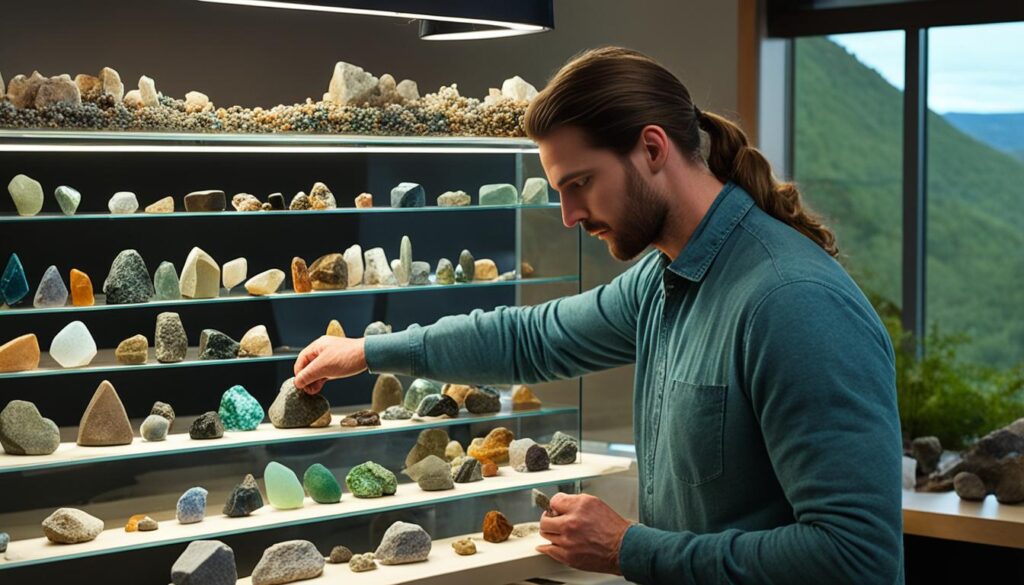
Advanced Tips for Serious Collectors
When rock collecting ascends from a casual interest to a serious hobby, it calls for a shift in strategy. The fine art of curating a quality collection is in recognizing not only the inherent beauty but also the geological significance of each specimen. You, the experienced rockhound, must now play the long game, focusing on rarity and perfection rather than accumulation.
Curating a Quality Collection
Establishing clear criteria for your collection limits is critical. By setting a size or type limit, you initiate a practice of selectivity that elevates the worth of your array. Consider creating a table of characteristics that define what deserves a space in your collection. This could range from color and clarity to proven historical significance. Trade, sell, or donate the pieces that fall short of these benchmarks, making room for pieces that add allure and value to your collection.
Trade and Relationships with Dealers
Effective trading and dealing in rockhounding is heavily rooted in trust and reputation within the community. Building relationships with reputable dealers is a two-way street that can lead to a wealth of opportunities. They’ll be your first call for acquiring sought-after pieces and can become trusted advisors who share your passion for the hobby.
Nurturing these connections means you’ll hear about the finest specimens first, offering you the right of first refusal. And when you’re ready to purchase, here’s a simple yet critical tip: buy the best within your budget. High-grade specimens not only enhance the diversity and significance of your collection but can also appreciate in value over time, making each addition a potential investment.
| Characteristics | Common Specimens | Purchasing Tips |
|---|---|---|
| Rarity | Basalt | Attend trade shows |
| Quality | Quartz | Seek out reputable dealers |
| Size | Calcite | Set an upper limit on specimen size |
| Historical Significance | Fossiliferous Limestone | Research provenance |
Remember: The distinction of your collection lies in the uniqueness and quality of each piece you add to it. Quality over quantity is the collector’s creed, ensuring rock collecting as a serious hobby remains a fulfilling and evolving pursuit.
Exploring Further: Books and Online Resources
As you delve deeper into the fascinating world of rockhounding, your journey should be guided by an ever-expanding library of rockhounding books and a wealth of online rockhounding resources. To thrive in this hobby, it’s critical to continuously build upon your foundation of knowledge, and there’s no better way to do so than by engaging with the comprehensive materials available to you.
The Value of Comprehensive Reference Materials
Investing in a collection of authoritative rockhounding literature is more than a mere accumulation of books; it’s an investment in your growth as a rockhound. Authors such as John Sinkankas have laid out a treasure map in the form of written knowledge, with each page bringing you closer to understanding the complexities and nuances of the minerals you seek. A robust library, featuring titles that span from regional guides to scientific texts, becomes an invaluable reference that you’ll return to time and again.
Expanding Knowledge through the Rockhounding Community
While books may serve as your silent mentors, the online rockhounding community is a living, breathing ecosystem rich with shared experiences and wisdom. Platforms such as Reddit and various rockhounding forums are teeming with discussions, personal findings, and the latest updates in the field. Participation in these communities not only broadens your perspective but also connects you with enthusiasts and experts who are just as eager to dispense advice as they are to learn.
Remember, the more you immerse yourself in the resources at your fingertips, the more skilled you’ll become in locating, identifying, and appreciating the geological wonders that lie beneath our feet.
Hands-On Learning: Rockhounding Workshops and Events
If you’re eager to dive deep into the world of rocks and minerals, rockhounding workshops and rockhounding events are the perfect settings to enrich your knowledge and skills. These gatherings are not only educational but offer a community space where novices and seasoned rockhounds alike can share their passion for the earth’s natural treasures.
Workshops are particularly beneficial for hands-on learning. Here, under the tutelage of experts, you’ll get to handle a variety of specimens and learn the techniques for identifying, extracting, and preserving them. Similarly, rockhounding events may include field trips, demonstrations, and lectures, exposing you to a wider array of experiences and insights.
Participation in these events fosters a shared sense of discovery and respect for the geological world, making every find a collective victory.
To maximize your opportunities in this hobby, keep an eye out for announcements from local clubs or mineral societies. They regularly host rockhounding workshops and plan rockhounding events that cater to all levels of interest and expertise. The table below highlights the typical offerings you can expect to find at these gatherings:
| Workshop/Event Type | Activities | Benefits |
|---|---|---|
| Identification Workshops | Hands-on specimen analysis | Enhanced recognition skills |
| Field Trips | Guided collection expeditions | Real-world collecting experience |
| Lectures & Demonstrations | Educational presentations by experts | Expanded geological knowledge |
| Networking Events | Meet-and-greet with fellow rockhounds | Formation of community and exchange of tips |
| Exhibitions | Display of unique and rare specimens | Inspiration and learning from curated collections |
Whether you are hone your identification skills or simply seeking camaraderie among fellow enthusiasts, the world of rockhounding workshops and rockhounding events awaits you. So put on your gear, mark your calendar, and prepare to explore the rich tapestry of geology with hands-on enthusiasm. Your journey through the layers of the earth’s history is bound to be filled with exciting discoveries and invaluable learning experiences. So, take the leap and immerse yourself in learning by doing.
Conclusion
The path to cultivating a personal collection of geological wonders is as enriching as it is vast. For those who set out on this exhilarating venture, the joys of rock collecting become evident with each unique find, enriching the soul and the soil under their fingertips. It’s an adventure marked by persistent discovery and ongoing growth, with the allure of the earth’s natural treasures as your constant companion.
The Joy of Building Your Own Collection
Building your own collection can offer a profound sense of achievement. Each rock, each mineral tells a story—a narrative of geological epochs or the result of happenstance right beneath our feet. The satisfaction derived from unearthing, cleaning, and classifying these finds is palpable, delivering not just aesthetic pleasure but an appreciation for the complexity and history of our planet.
Continuing Your Rockhounding Education
Your education in rockhounding doesn’t cease with the filling of a display case. It is an ongoing journey, ripe with opportunities for growth and learning. Engaging with rockhounding clubs, absorbing literature, participating in workshops, and nurturing community ties all contribute to a deeper understanding and proficiency in this captivating pursuit. As your collection grows, so too will your knowledge, ensuring that the adventure of rockhounding delivers new experiences and joys for years to come.
FAQ
How can I begin rockhounding as a beginner?
What essential rockhounding tools do I need?
Where can I find beginner-friendly rockhounding locations?
How can I identify the rocks and minerals I find?
What should I consider when planning my first rockhounding trip?
How should I catalog and maintain my rock collection?
What are some advanced tips for growing my rock collection?
Are there community resources for rockhounds to share knowledge and experiences?
Where can I find comprehensive reference materials for rockhounding?
How can I continue educating myself in rockhounding?
Source Links
- https://outdoorswire.usatoday.com/2023/03/16/rockhounding-tips/
- https://www.unearthedstore.com/blogs/guides/beginners-guide-to-rockhounding
- https://www.irocks.com/rock-and-mineral-collecting-for-beginners
This post contains affiliate links.
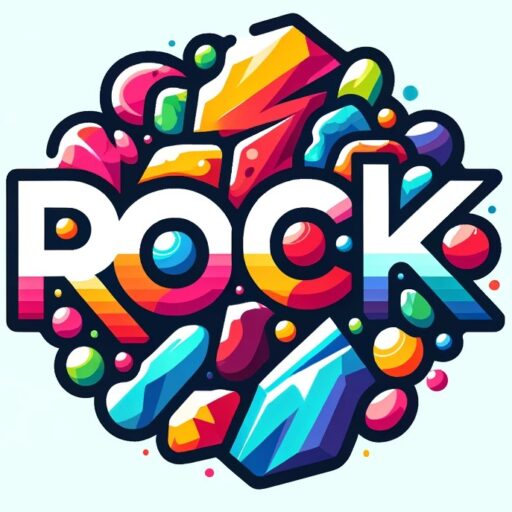
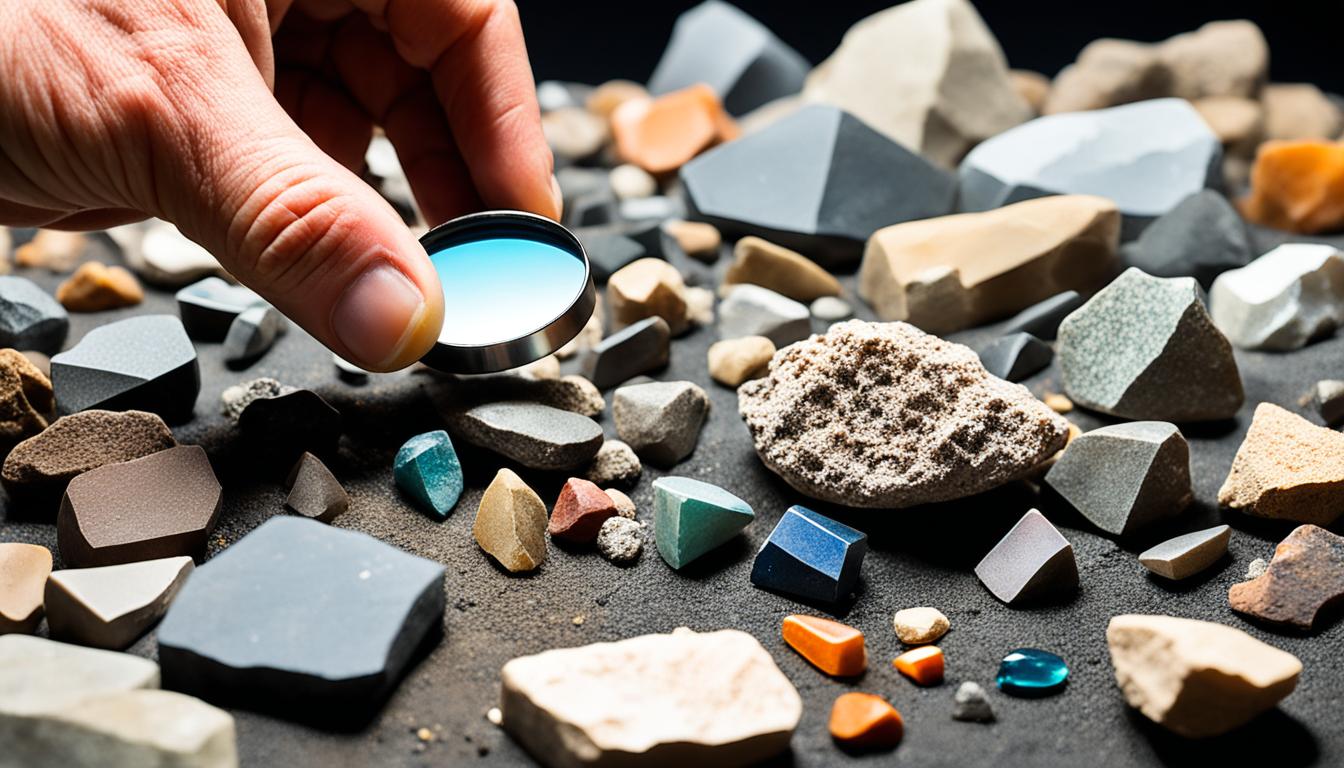
[…] to successful endeavors. Setting out, your first step is simple: equip yourself with the must-have rockhounding accessories. These include not only tools but also personal protective equipment to ensure you stay […]